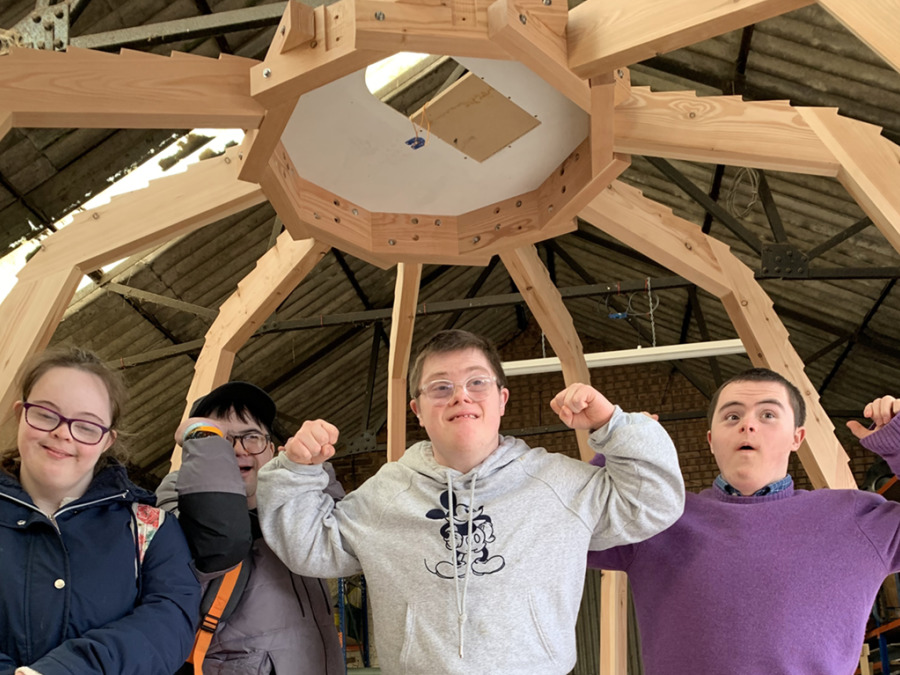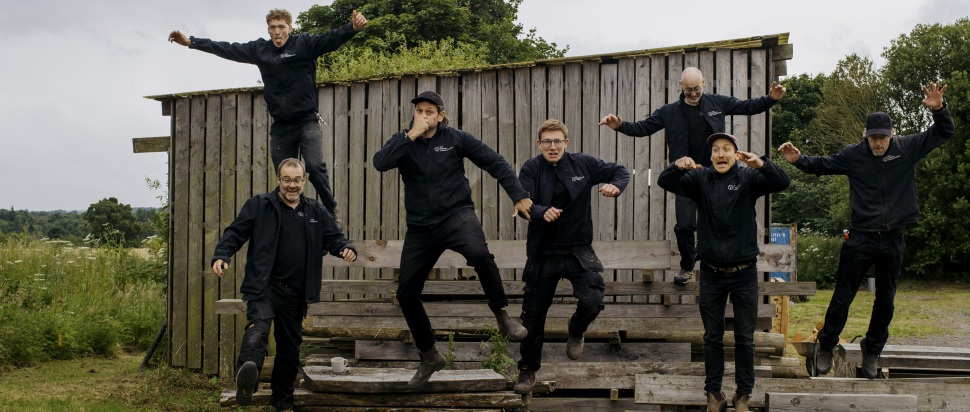Big Hugs: Old School Fabrications at Chelsea Flower Show
This month we meet Old School Fabrications to explore their special commission ‘the hug’ which travels to the RHS Chelsea Flower Show, an international showcase of horticultural design excellence
Old School Fabrications is a specialist design and build workshop based in rural Midlothian. It was founded by Neville Rae and Scott Laverie who trained in Environmental and Fine Art at The Glasgow School of Art and Edinburgh College of Art respectively. The team they have assembled is a unique blend of disciplines, where artists collaborate with architects, product designers work alongside furniture makers, and interior, exhibition, and textile designers contribute their distinct perspectives. Together, they tackle projects that blur traditional disciplinary boundaries and redefine creative collaboration.
This year Old School Fabrications (OSF) celebrates 15 years of creativity, craftsmanship, and innovation with an exciting new commission that will be showcased to over 140,000 visitors this May at the prestigious RHS Chelsea Flower Show. It’s a timber structure that forms part of a show garden for Down’s syndrome Scotland created by Duncan Hall and Nick Burton of Burton Hall Garden Design. The duo drew their inspiration for the garden from Hall’s seven-year-old nephew, Liam, who has Down’s syndrome and the project is supported by Down’s Syndrome Scotland.
Their brief to OSF was to design a building that represented an embrace. “Empathy, sensitivity and compassion are all qualities that people with Down’s Syndrome have in abundance, and this building perfectly encapsulates that,” says Rae. “Our design has now become affectionately known as ‘the hug’.”
Throughout the design process, the OSF team felt it was important to make the structure feel playful, welcoming and approachable, in a way that evokes the feeling of a child’s den. The design features eight generously sized seats, each positioned between the vertical spines of the structure to make the visitor feel as though they are being comfortably held, in a similar way to a wingback chair. The ergonomic design of the seating was carefully considered to offer a relaxed and gently reclined position.
When seen from above, the hug is based on a decagon with the ten cladded faces of the structure all feeding into a robust central component, comprised of ten interlocking ‘tetris blocks’ explains Laverie. “This core shape enabled us to avoid sharp and angular forms, instead bringing a softness and welcoming feel to the spherical structure. The top opening drew inspiration from a traditional yurt, allowing for a large circular skylight to illuminate the interior of the shelter and provide views of the moving clouds and trees above.”

Down's Syndrome Scotland at the workshop. Image courtesy of Old School Fabrications.
Consisting of around 2,500 plants, the garden has a number of specimen trees, including a large Scots Pine. It also has a number of structural features including water pools, bespoke benches, and artisan ceramic tiles designed by Scotland-based makers and creatives including Angie Lewin, Frances Priest Studio, and Laurence McIntosh.
For the final shelter OSF chose a native larch for outdoor use that would silver and age naturally over time. Each piece of carefully selected timber was dressed down, before a range of sawing and milling techniques were used to create the component parts for the structure. The build involved an array of both contemporary and traditional processes, from cutting edge CNC milling and table sawing, to hand chiselling and joinery.
“Reusing waste material, we created a full-sized prototype segment of the structure in the earlier stages of the design process to test ergonomics and the robustness of the structure,” says Rae. The complexities of making a spherical structure from straight pieces of wood meant that each piece of cladding on the ten sides of the structure required different angles to be cut into them. In this instance, having a team of both designers and makers allowed for design issues to be quickly ironed out and alterations made in an ad-hoc way with a strong feedback loop between studio and workshop.
“It’s a close and communicative way of working that is vital for the successful fabrication of the intricate design elements of a structure like the hug,” explains Laverie. Rae describes how a special visit from Down’s Syndrome Scotland informed the process of the project: “We had the pleasure of welcoming a fantastic group of teenagers from Down’s Syndrome Scotland to our workshop for an inspiring afternoon. They got a tour and a behind-the-scenes look at the progress of 'the hug', and learned about its role in Burton Hall’s garden at RHS Chelsea. The group joined us for a specially designed workshop, where they sanded and oiled wood samples using various water-based stains – exploring how simple techniques can dramatically transform natural materials.
“Using some of the leftover timber from the construction of ‘the hug’, they also learned how to craft coffee coasters, so each member had a memorable and useful piece of the garden building to take home.”
The hug will sit within a green, calm area of the garden at RHS Chelsea, which accentuates the sensitive expression of the building. This intention reflects the future relocation site of the garden at Watch US Grow in Palacerigg Country Park, North Lanarkshire where it will provide a welcome opportunity for people to sit within its calm surroundings. Several members of Down’s Syndrome Scotland will also be involved in the construction of the garden when it returns to Scotland.
The project has been made possible thanks to the generous sponsorship of Project Giving Back, a grant-making charity that supports gardens for good causes at RHS Chelsea before relocating them to sites across the UK.
@oldschoolfabrications
@localheroesdesign
